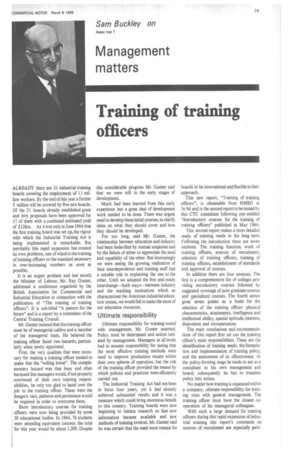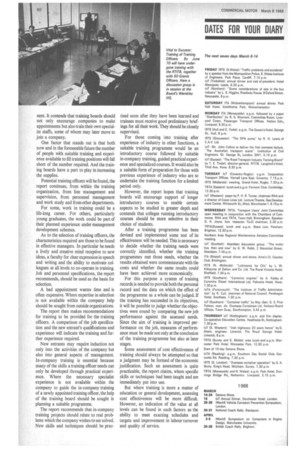Training of training officers
Page 81

Page 82

If you've noticed an error in this article please click here to report it so we can fix it.
ALREADY there are 21 industrial training boards covering the employment of 11 million workers. By the end of this year a further 5 million will be covered by five new boards. Of the 21 boards already established grant and levy proposals have been approved for 17 of them with a combined estimated yield of £128m. As it was only in June 1964 that the first training board was set up, the vigour with which the Industrial Training Act is being implemented is remarkable. But inevitably this rapid expansion has created its own problems, one of which is the training of training officers to the standard necessary in ever-increasing numbers as soon as possible.
It is an urgent problem and last month the Minister of Labour, Mr. Ray Gunter, addressed a conference organized by the British Association for Commercial and Industrial Education in connection with the publication of "The training of training officers". It is sub-titled "A pattern for the future" and is a report by a committee of the Central Training Council.
Mr. Gunter insisted that the training officer must be of managerial calibre and a member of the managerial team. He believed the training officer faced two hazards, particularly when newly appointed.
First, the very qualities that were necessary for making a training officer tended to make him the "willing horse". The complementary hazard was that busy and often harassed line managers would., if not properly convinced of their own training responsibilities, be only too glad to hand over the job to the training officer. These were the dangers: tact, patience and persistence would be required in order to overcome them.
Short introductory courses for training officers were now being provided by some 30 educational bodies. In 1964, 76 students were attending equivalent courses: the total for this year would be about 1,200. Despite this considerable progress Mr. Gunter said that we were still in the early stages of development.
Much had been learned from this early experience but a great deal of development work needed to be done. There was urgent need to develop these initial courses, to clarify ideas on what they should cover and how they should be developed.
For too long, said Mr. Gunter, the relationship between education and industry had been bedevilled by mutual suspicion and by the failure of either to appreciate the need and capability of the other. But increasingly we were seeing the growing realization of their interdependence and training staff had a notable role in explaining the one to the other. Until we adopted the free and ready interchange—both ways—between industry and the teaching institutions which so characterized the American industrial education scenes, we would fail to make the most of our education resources.
Ultimate responsibility
Ultimate responsibility for training rested with management, Mr. Gunter asserted. Policy must be determined and action initiated by management. Managers at all levels had to assume responsibility for seeing that the most effective training methods were used to improve production results within their own spheres of operation, but the role of the training officer provided the means by which policies and practices were efficiently carried out.
The Industrial Training Act had not been in force four years, yet it had already achieved substantial results and it was a measure which could bring enormous benefit to this country. Training boards were now beginning to initiate research so that new information became available and new methods of training evolved. Mr. Gunter said he was certain that the need must remain for boar& to be innovational and flexible in their approach.
This new report, "Training of training officers", is obtainable from HMSO at 3s 9d and is the second report to be issued by this CTC committee following one entitled "Introductory courses for the training of training officers" published in May 1966.
This second report makes a more detailed study of training needs in the long term. Following the introduction there are seven sections: The training function, work of training officers, sources of recruitment, selection of training officers, training of training officers, establishment of standards and approval of courses.
In addition there are four annexes. The first is a comprehensive list of colleges providing introductory courses followed by suggested coverage of post-graduate courses and specialized courses. The fourth annex gives seven points as a basis for the selection of the training officer: physical characteristics, attainments, intelligence and intellectual ability, special aptitude, interests, disposition and circumstances.
The main conclusions and recommendations of this report first set out the training officer's main responsibilities. These are the identification of training needs, the formulation and implementation of training policy, and the assessment of its effectiveness. At the policy-forming stage he tends to act as a consultant to his own management and board; subsequently he has to translate policy into action.
No matter how training is organind within a company, ultimate responsibility for training rests with general management. The training officer must have the closest cooperation of his managerial colleagues.
With such a large demand for training officers during this rapid expansion of industrial training this report's comments on sources of recruitment are especially perti nent. It contends that training boards should not only encourage companies to make appointments but also train their own specialist staffs, some of whom may later move to join a company.
One factor that stands out is that both now and in the foreseeable future the number of people with suitable training and experience available to fill training positions will fall short of the number required. And the training boards have a part to play in increasing the supplies.
Potential training officers will be found, the report continues, from within the training organization, from line management and supervision, from personnel management and work study and from other departments.
For some, work in training could be a life-long career. For others, particularly young graduates, the work could be part of their planned experience under management development schemes.
As to the selection of training officers, the characteristics required are those to be found in effective managers. In particular he needs a lively and creative mind receptive to new ideas, a faculty for clear expression in speech and writing and the ability to motivate colleagues at all levels to co-operate in training. Job and personnel specifications, the report recommends, should be used as the basis for selection.
A bad appointment wastes time and is often expensive. Where expertise in selection is not available within the company help should be sought from outside organizations.
The report then makes recommendations for training to be provided for the training officers. A comparison of the job specification and the new entrant's qualifications and experience will indicate the training and further experience required.
New entrants may require induction not only into the activities of the company but also into general aspects of management. In-company training is essential because many of the skills a training officer needs can only be developed through practical experience. Where the necessary specialist experience is not available within the company to guide the in-company training of a newly appointed training officer, the help of the training board should be sought in planning a suitable programme.
The report recommends that in-company training projects should relate to real problems which the company wishes to see solved. New skills and techniques should be prac tised soon after they have been learned and trainees must receive good preliminary briefings for all their work. They should be closely supervised.
For those coming into training after experience of industry in other functions, a suitable training programme would be an introductory course followed by suitable in-company training, guided practical experi ence and speciali7ed courses. It would also be a suitable form of preparation for those with previous experience of industry who are to undertake the training function for a limited period only.
However, the report hopes that training boards will encourage support of longer introductory courses to enable certain aspects to be studied in greater depth and contends that colleges running introductory courses should be more selective in their choice of students.
After a training programme has been devised and implemented some test of its effectiveness will be needed. This is necessary to decide whether the training needs were correctly identified, whether the training programmes met those needs, whether the results obtained were commensurate with the costs and whether the same results could have been achieved more economically.
For this purpose a system of training records is needed to provide both the personal record and the data on which the effect of the programme as a whole can be judged. If the training has succeeded in its objectives, it will be possible to judge whether the objec tives were sound by comparing the new job performance against the assessed needs.
Since the aim of training is improved performance on the job, measures of performance must be made not only at the conclusion of the training programme but also at later stages.
Some assessment of cost effectiveness of training should always be attempted so that a judgment may be formed of the economic justification. Such an assessment is quite practicable, the report claims, where specific skills or techniques had been taught and are immediately put into use.
But where training is more a matter of education or general development, assessing cost effectiveness will be more difficult.
However, an indication of the value at all levels can be found in such factors as the ability to meet exacting schedules and targets and improvement in labour turnover and quality of service.




































































































































